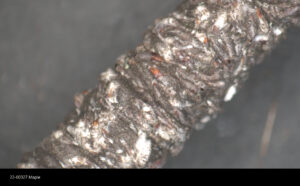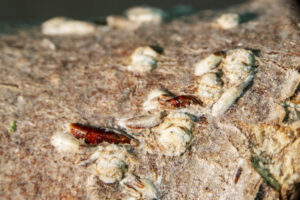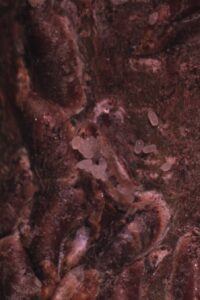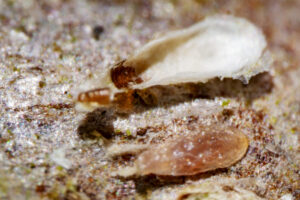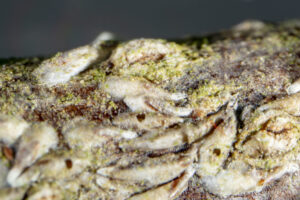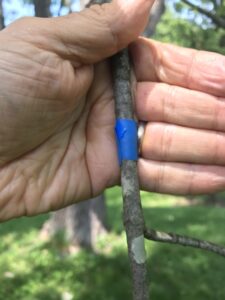Japanese maple scales (JMS) attack a wide variety of trees and shrubs. They are common on dogwood, elms, flowering fruit trees, maples, magnolias, lilac and roses. Heavy infestations can kill tree branches. Unlike the closely related soft scales, these insects will be dry and not coated with sticky liquid excrement. All stages of this scale can be separated from the plant tissue by flipping them over with a fingernail without ripping the plant surface. If you remove a bump on a plant and the tissue rips, this means the plant has produced a gall or swelling in response to an insect or disease and the bumps are not scale insects.
- Figure 1. Heavy infestations of Japanese maple scales can encrust twigs and kill stems of a wide variety of trees (Photo by T. Creswell).
- Figure 2. Mature JMS are covered with white wax. When the wax is rubbed off by wind or nearby twigs, the brown cover remains.
Wintering as mated and immature females, eggs hatch into flat wingless insects called crawlers. Crawlers walk on stems until they settle to attach themselves to the stems and start to feed. Scales use a fine, wire-like tube to pierce plant tissue and suck its liquid co
ntents. Soon after scales begin feeding they become translucent. Female scales remain where they have settled for the remainder of their lives. Males fly away from their feeding sites only after they have developed wings.
What to do if you think you have Japanese maple scale? Verify that you have JMS and not oystershell scale, which is much easier to control. At this time of year, oystershell scales will have eggs beneath their waxy covers and not the brown or purple bodies filled with fluid. Oystershell scales are easy to control because they have shorter and more distinct crawler periods
- Figure 3. When the covers of live oystershell scales are flipped over, they reveal the translucent white eggs.
- Figure 4. When the covers of live JMS are flipped over, they can reveal the brown fleshy body of the armored scales.
Earlier this year, you could have applied horticultural oil during dormant season to kill overwintered scales. This scale is very difficult to control during the growing season because the susceptible stage of crawlers is present throughout most of the summer. There are two generations a year in Indiana with crawlers being found from early May through June an again from mid August through September. The prolonged crawler period makes this insect particularly difficult to control with insecticides.
- Figure 5. Parasitic wasps that attacked and killed many of the Japanese maple scales in this photo, chewed holes through their waxy covers.
- Figure 6. Dark tape, wrapped around a twig sticky side up can be a good way to monitor for the crawling stage scale of insects. Crawlers get stuck in the glue and are easy to see with a magnifying lens.
Homeowners can apply horticultural oil in early or late June. Professionals can apply pyriproxifen, buprofizen, or azadirachtin at this time and may get better results. Each of these produces will kill crawlers but not natural enemies. Repeat in August if scales are still alive.
To protect bees, do not apply insecticide when plants are flowering. Oil will only kill bees during the 4 hours it takes to dry after spraying.
